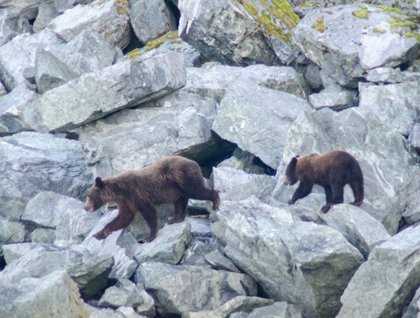Today’s adventures started last night as we picked up our National Park Ranger, Dan Zobrist and Tlingit Cultural Interpreter, Faith Grant from park headquarters in Gustavus. During the evening we sailed approximately 50 miles north into this unique national park accompanied by faint northern lights and a crest moon. First light cast an alpenglow on the high peaks of the Fairweather Range reflecting in Glacier Bay’s glassy waters. At daybreak, our guests were treated to sightings of nine brown bears, some mountain goats, and a black wolf all before breakfast.
We rounded Jaw Point and approached one of Alaska’s few advancing tidewater glaciers, the immense Johns Hopkins Glacier. Towering over 10,000 feet and feeding this advancing glacier, Mount Orville and Mount Wilbur provided a mirror image in the icy waters below the face. We spent a few hours observing shy harbor seals on ice floes that utilize this area for rearing their young while the canyon echoed with what the Tlingit people called “White Thunder.” This active glacier calved massive pieces of ice into the water causing roaring explosions.
Sailing south, Ranger Dan explained the park’s history and Faith shared her ancestral Huna Tlingit use of these lands for millennia. The Tlingit called this area Sít’ Eeti Gheeyi or The Bay in Place of the Glacier.
On our way back to Gustavus to return our specials guests, we encountered the usual Alaskan suspects; sea otters, sea lions, killer whales, puffins, and a breaching humpback whale to round out a perfect day in Glacier Bay National Park on the National Geographic Sea Lion.







